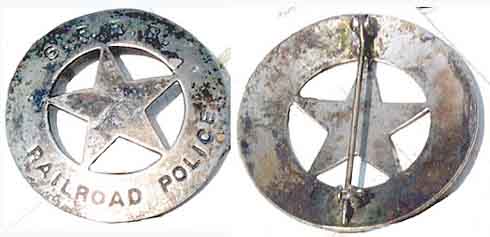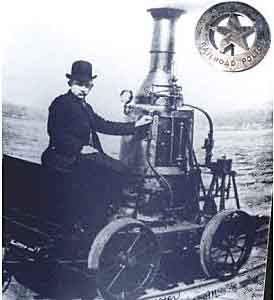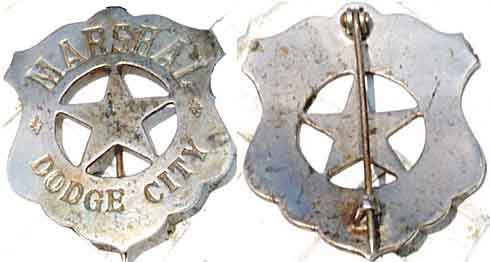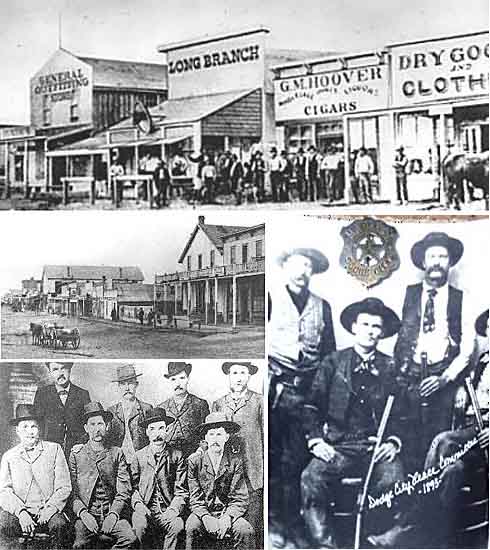wev
Moderator Posts: 4121
Registered: Apr 99
|
 posted 06-15-2003 03:19 PM
posted 06-15-2003 03:19 PM
  
Well, this was prompted by two, to my eye, dubious offerings on ebay.
quote:
Railroad Police Badge
Coin Silver badge. Southern Pacific Railroad Police. Circle surrounding five pointed star reading S.P.R.R. Police, Historical photo (8x10) comes with the badge. The original charter called for the Southern Pacific Railroad to go south from San Francisco through southern California through Arizona and New Mexico to El Paso, Texas but when the Central Pacific Railroad Big Four acquired it in 1868, the Southern Pacific Railroad would not end until it reached New Orleans Southern Pacific Railroad assistant chief engineer was William Hood who devised the ingenious method of eighteen tunnels in twenty eight miles of track climbing down from the Tehachapi Mountains to the San Joaquin Valley below. One of the most difficult was named the Great Tehachapi Loop. The switchback literally had the Southern Pacific Railroad train curved back on itself as it gained altitude. Southern Pacific Railroad tracks in March of 1880 reached Tucson and a celebration with a Golden spike was held. Charles Crocker of the Big Four did the honors. When a town would not grant privileges to the Southern Pacific Railroad, they simply built another town. This very scene happened when San Bernardino was left out and the Southern Pacific Railroad went through Colton, California. Again it occurred on May 11, 1880 when the Southern Pacific Railroad agents' came to evict the farmer from land that the government had originally granted to the Southern Pacific Railroad and violence ensued at Mussel Slough The farmers had been allowed to settle on the isolated land, cultivating it from a desert into a land of plenty with an irrigation system. In 1878, the Southern Pacific Railroad took title to the land and appraised the land at twenty five to thirty five dollars an acre instead of the two dollars and fifty cents originally stated The farmers lost every court case. By the end eight farmers died, five sentenced to eight months in jail and two hundred families were evicted from their farms As the railroads grew in power so did their monopoly on rates. The Southern Pacific's empire held a monopoly over freight in and out of the San Francisco and Oakland Bay area. In 1894, John Davie challenged the empire when he resisted building his Oakland warehouse on the Southern Pacific Railroad land. With a group of anti-railroad citizens supporting him they resisted the Southern Pacific Railroad men and police attacks. This was only the beginning! Davie began to run a nickel ferry in competition with the Southern Pacific Railroad 's fifteen cents slow ferries. Blocking his passage, Davie sank one of the Southern Pacific Railroad fleet. In retaliation, the Southern Pacific Railroad refused to open a drawbridge. Davie, in turn, tied onto a supporting beam and backed up, promptly putting the bridge in the bay. Although Davie was arrested, the grand jury refused to indict him. Public hostility to the Southern Pacific Railroad Monopoly was growing Badges worn by fast drawing, hard hitting police that protected the train from robbers in the 1880's. This badge was made by Langenbaker in Utah.


quote:
Dodge City Badge
Magnificent Dodge City Coin Silver badge. Dodge City. Wonderful five pointed star in shield. Badge comes with photo that it is lying next to at no additional cost The Shootout: The Deaths of Levi Richardson and Frank Loving In March of 1879, Levi Richardson and Frank Loving came face to face on Front Street in Dodge City, Kansas. An enmity existed between the two involving Mattie Loving, Frank's wife. Richardson struck Loving a blow to the face. Being unarmed, Frank walked away. Levi vowed then and there to eventually "blow the guts out of the cockeyed son-of-a------." "Cockeyed Frank" Loving, so called because "one of his optics bearing in a northeast direction to the other," was a 19-year old cowhand turned professional gambler. He was born in Jackson County, Missouri, about 1860, spending much of his childhood in Kansas City. In 1872 his father died but within a few months his mother remarried, the new family moving to Fort Worth, Texas. Eventually, Loving came up the trail to Dodge City and was now making his living as a gambler. The Ford County Globe said professional gamblers like Frank Loving "are desperate men. They consider it necessary in their business that they keep up their fighting reputation and never take a bluff." They went on to describe Loving as "not much of a rowdy, but more of the cool and desperate order." Other Gambling celebrities in town at this time included Doc Holliday, Rowdy Joe Lowe, John Allen, Bat Masterson, Wyatt S. Earp, and Charlie Bassett. Loving knew them all. Levi Richardson was from Wisconsin, coming to Southwest Kansas to make his fortune hunting buffalo. During the great slaughter it was not unheard of for a buffalo hunter and his crew to make more than $100.00 per day selling the hides to Rath and Wright, or Eugene LeCompt. H.H. (Henry) Raymond, who knew Richardson from the buffalo hunting grounds, said Richardson was an unpleasant man. Bat Masterson was Levi's friend. Richardson had also worked for Henry Stitler, cowboying for the man who erected the first sod house on what is now Dodge City. In April 1879, he was freighting between Dodge City and points south. Levi Richardson strode purposefully into the Long Branch saloon about dusk on Saturday, April 5, 1879. It was one of those cold, windy, early spring evenings in Dodge City, Kansas. As he entered, he looked over the crowd already assembled, scanning the room for Frank Loving. Richardson thought it was time to settle their differences. He knew that the Long Branch had come to be Loving's principal place of business; he was sure he would find Frank there. The famous Long Branch saloon, owned by Chalk Beeson and W. H. Harris, was the epitome of cowtown fancy. Paintings adorned the walls, revolvers decorated the patrons, and a steer head kept watch over the action on Front Street. It was the favorite for cattlemen and gamblers and witness to some of Dodge City's infamous events.
Gunplay was no stranger to the Long Branch saloon. When the canvas on the walls was removed in May 1882, twenty-five bullet holes were discovered, mute testimony to the action the patrons had seen over the years. April 5, 1879, brought to the Long Branch several of those bullet holes in one of Dodge City's most famous shootouts. About 8:00 p.m. that evening, Levi had given his personal papers to Sarah Warren telling her to take care of them. Mrs. Warren would later testify, "He said that if anything happened to him they would be no use to him; they would be mine". It seems obvious from this Levi Richardson was planning his duel with Frank Loving. Richardson headed for the bar situated along the east side of the Long Branch. He needed to start the fire in his belly that would chase away the chill of the cold evening and give him the courage to put his plan into action. The Gunfight After getting his drink, Richardson moved over to the pot-bellied stove in the front room of the saloon.
At some point between 8:30 and 9:00 p.m. he decided to move on, and headed for the door just as Frank Loving entered. Richardson immediately turned and followed Loving back into the Long Branch. Loving sat down on the hazard table, Richardson taking a seat near him on the same table. Richardson may, at this time, have begun to berate Loving, goading him into fighting. None of the witnesses seemed to know what was said. What is known is that Loving got up from the hazard table and said something unintelligible to Richardson and told him, "If you have anything to say about me why don't you come and say it to my face like a gentleman, and not to my back, you damn son-of-a------".
Richardson immediately stood up and said, "You wouldn't fight anything, you damn -------". Loving retorted, "You try me and see", whereupon Richardson drew his pistol and Loving drew his in response. What followed left the Long Branch filled with smoke, one man dead, one man slightly wounded, and the rest of the crowd hunting cover but miraculously unhurt. In the scramble one man crawled through the transom at the back door and another crawled into the ice chest hunting safety. The gunfight started by the stove in the front room. Edward Davies testified, "I saw ... Levi Richardson with a pistol in his hand. He was chasing Loving around the stove". He said that before he headed to the club room for
cover, he saw Richardson reach around the stove and fire at Loving. Charlie Bassett, Marshal of Dodge City and under Sheriff of Ford County, was several doors east of the Long Branch in Beatty & Kelley's saloon when he heard the gunfire. He immediately set out for the source of the disturbance. Bassett testified: "Saw Frank Loving, Levi Richardson and Duffey [Deputy Sheriff of Ford County]. Richardson was dodging and running around the billiard table. Loving was also running and dodging around the table..." Each was shooting at the other. Bassett also testified that when he was shown the pistols, Richardson's had five empty shells and Loving's Remington No. 44 was empty. Loving fell by the table by the stove, bystanders believing him to be shot. Deputy Sheriff Duffey grabbed hold of Richardson. Handling him easily, Duffey threw Richardson onto some chairs and came away with his gun. Bassett in the mean time had disarmed Loving. Richardson rose again, started toward the billiard table, and fell with a fatal wound to the chest. He had also been shot through the side and through the right arm. All Frank Loving had to show for it was a "slight scratch on the hand" according to the Ford County Globe. He was immediately hauled off to jail to await the verdict of the coroner's inquest. Wondrously, no one else in the entire room was injured. As the Globe stated "It seems strange that Loving was not hit, except a slight scratch on the hand, as the two men were so close together that their pistols almost touched each other".
Richardson's coat was on fire, so close was the discharge of Frank's Remington. Twenty-eight years old Levi Richardson was buried on Sunday, April 6, 1879, one more person to die with his boots on. James Richardson of Port Andrews, Wisconsin was in Dodge City two weeks later "looking after his brothers estate." Levi's father would arrive a while later. One more family to mourn a relative killed on the frontier. On Monday, April 7, 1879, a coroner's inquest was held and ruled that the killing was done in self-defense and Loving was immediately released. This badge was made by Langenbaker in Utah.


Both proport to be coin silver badges, but the seller has carefully refrained, while packing the description with un-related historical data, from giving any real information about the pieces other than they were made by "Langenbaker in Utah" (which I've never heard of) and implying, by association, an 1860-1880 dating. Since these sorts of pieces are fertile ground for fakery (even I could do one up in an afternoon) and the railroad piece has the sort of clasp in question, (which I thought usually indicated c 1900-1910 earliest date), I wondered what the story might be.Any opinion on them?
IP: Logged |

 SMP Silver Salon Forums
SMP Silver Salon Forums

 Silver Jewelry
Silver Jewelry

 clasp dating?
clasp dating?






















